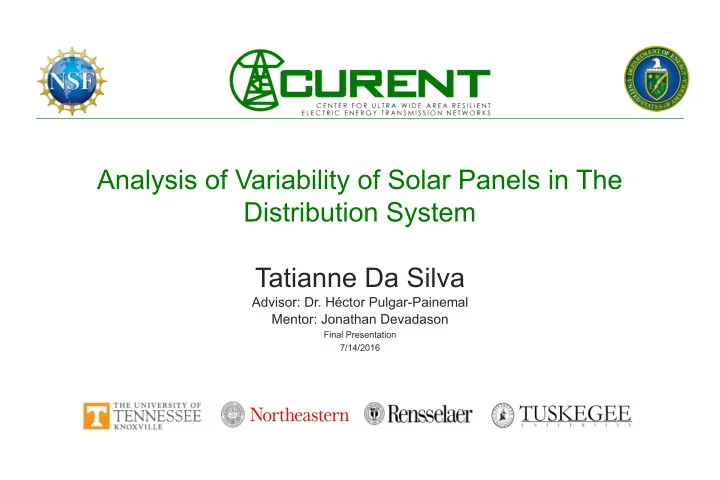

Analysis of Variability of Solar Panels in The Distribution System Tatianne Da Silva Advisor: Dr. Héctor Pulgar-Painemal Mentor: Jonathan Devadason Final Presentation 7/14/2016
Motivation Distribution System Substation Residences Solar Panels Static VAR Compensator (SVC) 2
Background • SVC (Static VAR Compensator) • Current Power Flow S P jQ V * I 3
• Mathematical Modelling The transients of the inductances of the distribution lines were neglected as they were assumed to be too fast Solar panels were modeled as power injections Dynamic model for SVC was considered 5-4
Cases • 4 bus system V0 V1 V2 V3 SVC 5
• 20 bus system S S S V V V C C C SP3 SP1 SP2 1 3 2 6
Results Analysis of bus voltage with and without SVC for the 4 bus system with 3 different solar irradiations Ppv = 1 0 < t < 5 Ppv = 1 0 < t < 5 Ppv = 1 0 < t < 5 Ppv = 1.1 5 < t < 7 Ppv = 1.1 5 < t < 7 Ppv = 1.1 5 < t < 7 Ppv = 1 7 < t <10 Ppv = 1.5 7 < t <10 Ppv = 0.8 7 < t <10 7
Results Analysis of bus voltage with and without SVC for the 20 bus system with various solar irradiations Ppv0 = 0.0001 0 < t < 5 Ppv4 = 0.0001 12 < t < 13 Ppv1 = 0.0001 5 < t < 7 Ppv5 = 0.0001 13 < t < 16 Ppv2 = 0.005 7 < t < 10 Ppv6 = 0.0001 16 < t < 16.5 Ppv3 = 0.0001 10 < t < 12 Ppv7 = 0.0001 16.5 < t < 20 8
Ppv0 = 0.0001 0 < t < 5 Ppv4 = 0.0001 12 < t < 13 Ppv1 = 0.0001 5 < t < 7 Ppv5 13 < t < 16 Ppv2 7 < t < 10 PV 1 = 0.009 PV 1 = 0.003 PV 2 = 0.005 PV 2 = 0.005 PV 3 = 0.009 PV 3 = 0.003 Ppv6 = 0.0001 16 < t < 16.5 Ppv3 = 0.0001 10 < t < 12 Ppv7 = 0.0001 16.5 < t < 20 9
Ppv0 = 0.01 0 < t < 5 Ppv4 = 0.0001 12 < t < 13 Ppv1 = 0.0001 5 < t < 7 Ppv5 13 < t < 16 Ppv2 7 < t < 10 PV 1 = 0.009 PV 1 = 0.003 PV 2 = 0.005 PV 2 = 0.005 PV 3 = 0.009 PV 3 = 0.003 Ppv6 = 0.0001 16 < t < 16.5 Ppv3 = 0.0001 10 < t < 12 Ppv7 = 0.0001 16.5 < t < 20 PV 1 = 0.002 PV 2 = 0.007 10 PV 3 = 0.002
5-11
Conclusion With the implementation of SVCs it is possible to maintain the bus voltage within an acceptable band compared with the cases without SVCs when there are variations in the solar panel output. 12
Acknowledgements This work was supported primarily by the ERC Program of the National Science Foundation and DOE under NSF Award Number EEC-1041877. Other US government and industrial sponsors of CURENT research are also gratefully acknowledged. 13
Questions and Answers 14
Recommend
More recommend